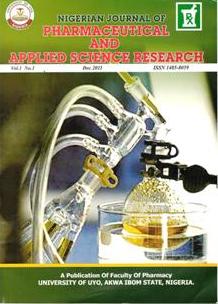Evaluation of the Acute Toxicity Profiles and Mouse Protection Tests of Aqueous Extracts of Ipomoea triloba (L.) and Glyphaea brevis (Malvaceae) in Singles and Combination on selected clinical isolates
Main Article Content
Abstract
Background
Acute Infectious Diarrhoea remains a significant global health issue and is a second leading cause of mortality and morbidity in Nigeria and worldwide in children below five years of age and geriartrics often caused by bacterial, viral, protozoal and helminthic infections that lead to dehydration and other complications. Hence, this study investigated the safety profile and degree of antidiarrhoeal protection offered by the plant extracts in singles and in combination.
Methods
The acute toxicity profiles and antidiarrhoeal (mouse protection tests) properties of aqueous extracts of Ipomoea triloba (L.) (IA) and Glyphaea brevis (GA) against selected clinical bacterial isolates (Escherichia coli, Salmonella typhii, Shigella spp, Klebsiella pnuemoniae, Proteus spp and Morganella morganii.) were evaluated in singles and in combination. These extracts were prepared using standardized methods, and their acute toxicity profiles were evaluated using improved Lorke’s method.
Results
Results indicated LD50 values of 2449.0 mg/kg (IA) and 2449.4 mg/kg (GA) respectively. Mouse protection tests showed 94.00±10.50% protection when the extracts were administered in combination whereas the protection was reduced (54.76 ± 12.60 %) IA and (57.14 ± 21.21%) GA when the extracts were administered singly to the animals thus validating the use of the aqueous extracts of both plants folklorically.
Conclusion
Conclusively, these findings suggest that these plants possess potential antidiarrhoeal properties with relative non-toxic profiles thus, supporting their use locally in treating diarrhoea-related ailments. Further investigation into the active compounds responsible for these effects is required and ongoing
Downloads
Article Details

This work is licensed under a Creative Commons Attribution-NonCommercial-NoDerivatives 4.0 International License.
References
Abolfathi, A. A., Mohajeri, D., Rezaie, A., Nazeri, M. (2012). Protective effects of green tea extract against hepatic tissue injury in streptozotocin induced diabetic rats. Evidence Based Complement Alternative Medicine. Volume 2012, Article ID 740671, 1-10.
Akhila J. S., Deepa S. and, Alwar M. C. (2007). Acute toxicity studies and determination of median lethal dose. Current Science, 93 (7): 917-920.
Alozie Mfonobong Favour, Ekong Ubong Samuel, Effiong Daniel Ekpa, Udofa Edidiong Jumbo, Akinjogunla Olajide Joseph (2022). Journal of Biology and Biotechnology Research 20(1): 1398-1408. https://dx.doi.org/10.4314/br.v20i1.2
Alozie MF, US Ekong, UI Anwana, EJ Udofa, OJ Akinjogunla, and TY Mirabeau. (2024). “Acute Toxicity and In Vivo Antidiarrhoeal Activity of Ethanol Extract and Fractions of Ipomoea triloba by Model Infection and Protection Tests in Mice Against Selected Clinical Diarrhoeagenic Bacterial Isolates”. Biotechnology Journal International. 28 (6):35-45. https://doi.org/10.9734/bji/2024/v28i6747.
Bhat, R. B., Etejere E. O., Oladipo V. T. (1990). Ethnobotanical studies from central Nigeria. Economy of Botany. 44: 382 390.
Ekong U. S., Udoh D. I., Alozie M.F., Udofa E.J. and Akpaide N. I. (2020). Investigation of the in vitro antidiarrhoeal activity of Hippocratea africana root extracts by model infection and protection test in mice against bacterial isolates from infectious diarrhoeal and gastroenteritis patients in Uyo, Nigeria. Nigerian Journal of Pharmaceutical and Applied Science Research. 9 (3):71-82.
Ekong, U. S, Mgbii, N. C., Moneke, Anv. and Obi, S. K. C. (2004). Evaluation of the anti-microbial and some pharmacokinetic properties of an antibiotic substance produced by an environmental Aspergillus species SK2. Nigerian Journal of Microbiology 18 (1-2): 199 – 206.
Etukudo, I. (2000) Forests: our divine treasure. Dorand Publishers, Uyo, Akwa Ibom State, Nigeria, 165p.
M. F. Alozie, U. S. Ekong, D. E. Effiong, E. J. Udofa, and O. J. Akinjogunla (2020). Evaluation of antibacterial properties of Ipomoea triloba L. extract on selected diarrhoeal bacterial isolates. Conference Paper in Annual National Conference on Bioscience and Biotechnology 2020 (BBC 32) Faculty of Biological Sciences, University of Nigeria, Nsukka.
Jiwok, J. C., Adebowale, A. S., Wilson, I., Kancherla, V. and Umeokonkwo, C. D. (2021). Patterns of diarrhoeal disease among under-five children in Plateau State, Nigeria, 2013–2017. BMC Public Health 21: 2086.
Lorke, D. (1983). A new approach to practical acute toxicity testing. Archives of toxicology, 53: 275- 289.
N’Guessan, K., Kadja B, Zirihi G, Traoré D, Aké Assi L. (2009). Screening phytochimique de quelques plantes médicinales ivoiriennes utilisées en pays Krobou (Agboville, Côte d’Ivoire). Science Naturalle. 6: 1-15.
NIH (1996). Guide for the Care and Use of Laboratory Animals. NIH Publication No. 85-23.
O’Callaghan, H. (1983). Assessment of new antibiotics in: Pharmaceutical Microbiology, Hugo, W. B. and Russel Butterworth, London.
World Health Organization (2022). Diarrhoeal disease. Retrieved from https://www.who.int/news-room/fact-sheets/detail/diarrhoeal-disease


